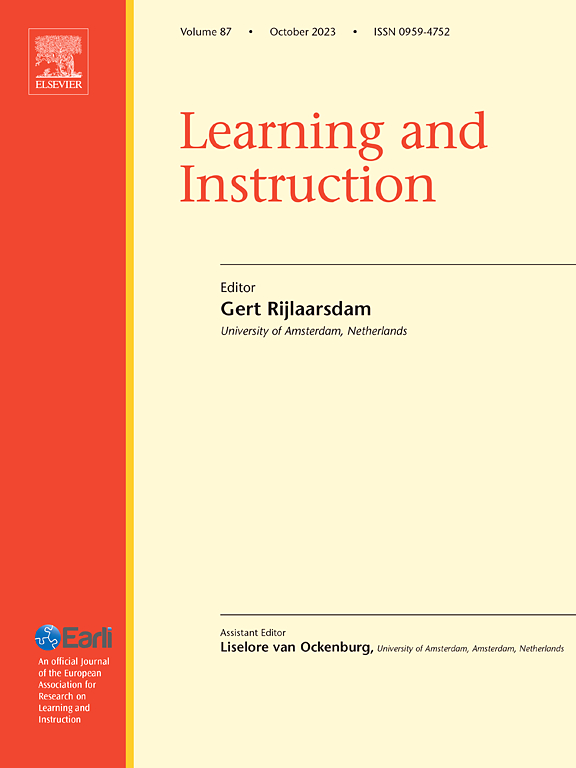Can the effects of generative drawing on lasting learning be optimized through integration of retrieval practice?
IF 4.9
1区 教育学
Q1 EDUCATION & EDUCATIONAL RESEARCH
引用次数: 0
Abstract
Background
Creating drawings to depict the content of an expository text triggers generative processes that contribute to the construction of coherent mental models and thus improves comprehension. However, the triggered generative processes scarcely contribute to consolidation of the mental models in memory. Hence, a promising means to optimize drawing in terms of lasting learning is incorporating retrieval practice, which has been shown to serve a robust consolidation function.
Aims
The goal of the present study was to investigate whether incorporating retrieval practice into drawing would foster lasting learning.
Sample
Participants were N = 308 students.
Methods
After reading an expository text, students were randomly assigned to one of two conditions. In the closed-then-open-book condition, learners first created their drawings without access to the text and hence were required to retrieve the previously read information from memory. Afterwards, they were asked to revise their drawings with access to the text. In the open-book condition, learners could access the text in all phases. Learning outcomes were assessed two and eight weeks later.
Results
The closed-then-open-book drawing was not superior in terms of learning outcomes. Mediation analyses suggest that the closed-then-open-book format fostered learning via increased retrieval practice but at the same time hindered learning via decreased mental model quality.
Conclusions
Implementing drawing in a closed-then-open-book format could in principle be a fruitful means to optimize drawing in terms of lasting learning. However, instructional support which ensures that mental model quality is not compromised is needed to exploit its full potential.
生成性绘画对持久学习的影响能否通过与检索练习的整合得到优化?
通过绘制图画来描述说明性文本的内容,可以触发生成过程,从而有助于构建连贯的心理模型,从而提高理解能力。然而,触发的生成过程几乎无助于巩固记忆中的心理模型。因此,在持久学习方面优化绘画的一个有希望的方法是结合检索练习,这已被证明具有强大的巩固功能。目的本研究的目的是探讨将检索练习纳入绘画是否会促进持久的学习。样本参与者为N = 308名学生。方法在阅读说明性文本后,学生被随机分配到两种情况中的一种。在先闭后开的条件下,学习者首先在没有书本的情况下画出他们的图画,因此要求他们从记忆中检索之前读过的信息。之后,他们被要求通过阅读课文来修改他们的图画。在开卷条件下,学习者可以在所有阶段访问文本。两周和八周后对学习结果进行评估。结果先闭卷后开卷的学习效果不明显。中介分析表明,先闭后开的书本模式通过增加检索练习促进了学习,但同时通过降低心智模型质量阻碍了学习。结论采用先闭后开的书本形式进行绘图,原则上是优化绘图持久学习的有效手段。然而,教学支持,确保心理模型的质量是不妥协的,需要开发其全部潜力。
本文章由计算机程序翻译,如有差异,请以英文原文为准。
求助全文
约1分钟内获得全文
求助全文
来源期刊

Learning and Instruction
Multiple-
CiteScore
11.30
自引率
4.80%
发文量
109
期刊介绍:
As an international, multi-disciplinary, peer-refereed journal, Learning and Instruction provides a platform for the publication of the most advanced scientific research in the areas of learning, development, instruction and teaching. The journal welcomes original empirical investigations. The papers may represent a variety of theoretical perspectives and different methodological approaches. They may refer to any age level, from infants to adults and to a diversity of learning and instructional settings, from laboratory experiments to field studies. The major criteria in the review and the selection process concern the significance of the contribution to the area of learning and instruction, and the rigor of the study.
 求助内容:
求助内容: 应助结果提醒方式:
应助结果提醒方式:


